| Pages:
1
2 |
FluoroPunch
Harmless

Posts: 33
Registered: 13-4-2019
Location: Canada
Member Is Offline
|
|
Steam distillation of mint - not working?
Hey guys,
I tried twice to steam distill mint essential oil with no success. I've obtained orange essential oil so I figured it should be the same for mint.
The mint I used was grown in our backyard (Canada). The first batch I simply stuffed a 500mL RBF with leaves and tried to distill, probably around
600mL of water total. I distilled straight into a 500mL sep funnel to avoid losses but still got no discernible layer. (Smelled really good though.) I
tried (stupidly) extracting with xylene but when I boiled down the xylene I was only left with some brown tar that may have had some faint smell of
mint. The second attempt I believe I used several more plants than the first, however I ran them through the food processor. (I didn't think weighing
anything would be necessary/I was to lazy too, so I don't know exactly how much I used.) After distillation of ~750mL water, again there was no
discernible layer. (I added salt both runs to the resulting solution to hopefully achieve phase separation, no luck.) I split the second batch into
two 375mL portions and extracted each with 2x20mL of DCM. I just finished distilling the ~50-60mL of DCM in a hot water bath (max temp ~92°C) and was
left with a very small residue at the bottom of the flask that smells awful.
Does anyone have any idea why I wasn't able to get any oil? I admit in both runs I overfilled the flask and it frothed and overflowed into the sep
funnel, making for some nasty emulsions. I don't think that should have caused the problem though. I was thinking to try to grind up the leaves a bit
in a mortar and pestle and to try to stuff more in the flask. Any help is appreciated.
|
|
|
Abromination
Hazard to Others
  
Posts: 432
Registered: 10-7-2018
Location: Alaska
Member Is Offline
Mood: 1,4 tar
|
|
When I tried this a year back, I could not get any product because the oil stayed in suspension. If you look closer, you will probably notice very
small droplets mixed in with the water.
List of materials made by ScienceMadness.org users:
https://docs.google.com/spreadsheets/d/1nmJ8uq-h4IkXPxD5svnT...
--------------------------------
Elements Collected: H, Li, B, C, N, O, Mg, Al, Si, P, S, Fe, Ni, Cu, Zn, Ag, I, Au, Pb, Bi, Am
Last Acquired: B
Next: Na
-------------- |
|
|
PirateDocBrown
National Hazard
   
Posts: 570
Registered: 27-11-2016
Location: Minnesota
Member Is Offline
Mood: No Mood
|
|
The principal constituent of mint, menthol, has a boiling point far above that of water. (214C)
Steam distillation will have poor results. Do a solvent extraction, instead.
[Edited on 8/31/19 by PirateDocBrown]
Phlogiston manufacturer/supplier.
For all your phlogiston needs.
|
|
|
UC235
National Hazard
   
Posts: 565
Registered: 28-12-2014
Member Is Offline
Mood: No Mood
|
|
Mint is routinely steam distilled for production of the essential oil. I think you're wildly underestimating how much mint you need to distill to get
any appreciable yield. Mint leaves aren't very dense and oil yield is only 1-2% with exhaustive distillation.
|
|
|
Ubya
International Hazard
    
Posts: 1247
Registered: 23-11-2017
Location: Rome-Italy
Member Is Offline
Mood: I'm a maddo scientisto!!!
|
|
Quote: Originally posted by UC235  | | Mint is routinely steam distilled for production of the essential oil. I think you're wildly underestimating how much mint you need to distill to get
any appreciable yield. Mint leaves aren't very dense and oil yield is only 1-2% with exhaustive distillation. |
i did many mint steam distillations (i love mint and i have 4 pots on my terrace of just mint) in the past, what UC235 said is right, i always used a
1L flask compact full to the brim (causing a few times overflow lol) after distilling 500ml of water i got way less than 1 ml, it wasn't a layer of
oil, it was more like patches on the surface. the yield is very low, the only way is to use a bigger vessel and much more mint (i never weighted it, i
just put as much as i could in a 1L flask). plus the amount of oil depends on the mint you are using, i always used the spicata, because that's what
they sold as a plant, but now i got quite a collection of varieties, glacial mint and piperita mint have the strongest and freshest smell (more
menthol), spicata smells like mint but doesn't have the freshness, the orange mint i have smells of mint+bergamotto hahahaha. in a few days i'm going
to harvest my mint and try to steam distill it, i'll let you know how it goes, but right now i have to focus on my exams
---------------------------------------------------------------------
feel free to correct my grammar, or any mistakes i make
---------------------------------------------------------------------
|
|
|
XeonTheMGPony
International Hazard
    
Posts: 1640
Registered: 5-1-2016
Member Is Offline
Mood: No Mood
|
|
Quote: Originally posted by PirateDocBrown  | The principal constituent of mint, menthol, has a boiling point far above that of water. (214C)
Steam distillation will have poor results. Do a solvent extraction, instead.
[Edited on 8/31/19 by PirateDocBrown] |
^^^^^^^^^^^^^^^^^^^^^^^^^^^^^^^^^^^^^^^^^^^^^^^^^^^^^^^^^^^^^^^^^^
That, I used 95 5 ethanol to do it, I never cared about the chlorophyll carry over.
I'd hang the mint stocks upside down in the fridge and dry them, then remove the leafs and coarsely crush, toss into a large jar of alcohol, I'd do 2
extractions then distill off the excess alcohol (Use that for next run of extractions.
It takes crap loads to make a rather good mind oil, pretty much a couple garbage bags worth (Largest type garbage bag)
|
|
|
Boffis
International Hazard
    
Posts: 1867
Registered: 1-5-2011
Member Is Online
Mood: No Mood
|
|
Try adding salt at the rate of about 300 g per l of distillate and then extra with Dom or either. Remember that fresh herbs contain much less than
1% oil in general and oxygen bearing components are often slightly soluble in water.
|
|
|
CycloKnight
Hazard to Others
  
Posts: 128
Registered: 4-8-2003
Member Is Offline
Mood: Still waiting for the emulsion to settle.
|
|
Quote: Originally posted by PirateDocBrown  | The principal constituent of mint, menthol, has a boiling point far above that of water. (214C)
Steam distillation will have poor results. Do a solvent extraction, instead.
[Edited on 8/31/19 by PirateDocBrown] |
Steam distillation doesn't work quite like that, its effectiveness is determined by vapour pressure, concentration, and enthalpy of vaporisation. It
doesn't matter if its boiling point is significantly above that of water.
Eugenol (for example) will volatilize in steam immediately, with dozens of ml distilling over per litre of condensate, despite having a boiling point
of 254 C.
|
|
|
PirateDocBrown
National Hazard
   
Posts: 570
Registered: 27-11-2016
Location: Minnesota
Member Is Offline
Mood: No Mood
|
|
That may all well be, but it nevertheless remains that, commercially, mint is extracted overwhelmingly by solvent extraction into ethanol, with
menthol separated by recrystallization at freezing temperatures. The predominant majority of menthol production from natural sources is done in India.
Phlogiston manufacturer/supplier.
For all your phlogiston needs.
|
|
|
Magpie
lab constructor
    
Posts: 5939
Registered: 1-11-2003
Location: USA
Member Is Offline
Mood: Chemistry: the subtle science.
|
|
There is a fair amount of mint grown in Eastern Washington. Here the farmers place the cut branches in a tank truck in the field. The truck is then
brought in to a steam boiler where steam is blown into the tank. The exiting steam is condensed to recover the mint. Spent leaves are removed and
the truck goes back into the field for more mint.
The single most important condition for a successful synthesis is good mixing - Nicodem
|
|
|
S.C. Wack
bibliomaster
    
Posts: 2419
Registered: 7-5-2004
Location: Cornworld, Central USA
Member Is Offline
Mood: Enhanced
|
|
Open sesame = Clevenger trap
https://books.google.com/books?id=W5jcwx85EoEC&pg=PA67
|
|
|
FluoroPunch
Harmless

Posts: 33
Registered: 13-4-2019
Location: Canada
Member Is Offline
|
|
Thanks for the input guys. So I guess I wasn't necessarily doing anything wrong? Guess I'll just try to stuff the flask more and hope for the best!
Clevenger might be nice actually (albeit expensive...). I have a very long condenser and little patience so I could let it distill for hours no
problem that way.
Does anyone know if the speed of the distillation matters at all for the yield? I can't find anywhere that explicitly says if there's any impact to
yield based on if its a "wet" or "dry" distillation.
|
|
|
CycloKnight
Hazard to Others
  
Posts: 128
Registered: 4-8-2003
Member Is Offline
Mood: Still waiting for the emulsion to settle.
|
|
The distillation speed will determine the distillation time, rather than the yield. Boil it as fast as you can.
If you're using a 500 ml RBF, I would suggest at least using freshly dried and then powdered leaves to ensure you can get enough into such a small
volume to make it worth your while. With fresh leaves in a 500 ml RBF, I'd imagine you'll get little more than residues. Also, the rate will be rather
slow without boiling over the top and into the condenser.
Lacking any other suitable steam distilling vessel (kettle, metal pot/lid, etc) that would be suitable and ideal for said purpose, I would consider
adapting a steam pressure cooker if you have one at hand. Just remove the pressure regulator weight and attach a rubber/flexible pvc tube over the
nipple, and run to a condenser. Even better to connect the tubing to thin copper tubing and run to the condenser. Insulate the copper tubing.
The lid rubber seal and tubing will likely absorb some of the oils, so best to minimize the rubber contact area. However, you'll be able to add so
much more mint, and run so much faster, that I'd imagine you'll likely get far better results (even with just fresh leaf) than using a 500 ml RBF.
If you try that approach, just ensure you put a mesh or a plate on top of the leaves, to prevent them from possibly blocking the exit hole and/or
pressure release safety valve.
|
|
|
CycloKnight
Hazard to Others
  
Posts: 128
Registered: 4-8-2003
Member Is Offline
Mood: Still waiting for the emulsion to settle.
|
|
This was how I did my last essential oil extraction:
http://www.sciencemadness.org/talk/viewthread.php?tid=90636
Though worth noting that this particular pressure cooker doesn't have a rubber seal for the lid, instead uses a metal sealing flange.
[Edited on 4-9-2019 by CycloKnight]
|
|
|
FluoroPunch
Harmless

Posts: 33
Registered: 13-4-2019
Location: Canada
Member Is Offline
|
|
Quote: Originally posted by CycloKnight  | The distillation speed will determine the distillation time, rather than the yield. Boil it as fast as you can.
If you're using a 500 ml RBF, I would suggest at least using freshly dried and then powdered leaves to ensure you can get enough into such a small
volume to make it worth your while. With fresh leaves in a 500 ml RBF, I'd imagine you'll get little more than residues. Also, the rate will be rather
slow without boiling over the top and into the condenser.
Lacking any other suitable steam distilling vessel (kettle, metal pot/lid, etc) that would be suitable and ideal for said purpose, I would consider
adapting a steam pressure cooker if you have one at hand. Just remove the pressure regulator weight and attach a rubber/flexible pvc tube over the
nipple, and run to a condenser. Even better to connect the tubing to thin copper tubing and run to the condenser. Insulate the copper tubing.
The lid rubber seal and tubing will likely absorb some of the oils, so best to minimize the rubber contact area. However, you'll be able to add so
much more mint, and run so much faster, that I'd imagine you'll likely get far better results (even with just fresh leaf) than using a 500 ml RBF.
If you try that approach, just ensure you put a mesh or a plate on top of the leaves, to prevent them from possibly blocking the exit hole and/or
pressure release safety valve.
|
Thanks for the tips! My thinking was that by using fresh leaves I'd have a greater yield per mass. I figured some oil would be lost by drying. I guess
I'll try the dry leaves method too. I might think to use a steam cooker one day if I keep steam distilling but for now its just for fun, just to have
a little vial of each oil.
|
|
|
CycloKnight
Hazard to Others
  
Posts: 128
Registered: 4-8-2003
Member Is Offline
Mood: Still waiting for the emulsion to settle.
|
|
No trouble fella! Indeed drying the leaves will no doubt cause some of the oil to be lost, the shear quantity of fresh leaves necessary to squeeze in
is the challenge. I needed to use the equivalent of over 3 kg of fresh leaves (though most already dried) for the piper auritum distillation, to yield
a little over 4 ml oil, at circa 1.52% oil yield from dried leaf. The next steam distillation I'll be doing will be using fresh leaves only, for the
aforementioned reason. Will be interesting to see the difference in yield.
Also, if you try using solvent extraction, bear in mind you can use activated carbon (just stir for several minutes, then filter) to remove the
chlorophyll from the extracts, which will really help to clean it up a lot.
|
|
|
zed
International Hazard
    
Posts: 2283
Registered: 6-9-2008
Location: Great State of Jefferson, City of Portland
Member Is Offline
Mood: Semi-repentant Sith Lord
|
|
Piper Auritum?
Sassafras root-bark itself, loses its mojo fairly rapidly. Safrole evaporates off over the course of a year or two, and the bark becomes much less
fragrant. The desirable component, has departed. And, THAT is the result for bark tightly wrapped in a plastic bag.
Fresh mint leaves, or fresh Piper leaves, should work much better than dried.
Also, I can confirm the mint extraction process used in America's Northwest. I spoke to a local Mint-oil producer a few years back. They fill a
trailer with freshly harvested mint, and they blow hot steam though it. They then collect the condensate. No mention of solvents.
Recent article: https://www.wisfarmer.com/story/news/2018/09/05/new-process-...
[Edited on 11-9-2019 by zed]
|
|
|
FluoroPunch
Harmless

Posts: 33
Registered: 13-4-2019
Location: Canada
Member Is Offline
|
|
Thats pretty interesting Zed, thanks for sharing. I don't think I'll have enough mint for a continuous process haha.
A note on the drying: I've found from a source (https://www.morningmystbotanics.com/wp-content/uploads/df431...) and even in the article cited by Zed, that drying may actually increase yield.
Industrially the feed for the steam distillations is dried, in the PDF I shared one of the plants had a peak oil yield around 2 days. I think this
makes sense since the plants wilt and lose some of their structural integrity and the oil can more easily diffuse. Yes, some oil will be lost to
evaporation, but the yield is also based on how well you can get all the oil out. Correct me if I'm wrong though.
|
|
|
Fery
International Hazard
    
Posts: 1015
Registered: 27-8-2019
Location: Czechoslovakia
Member Is Offline
|
|
I did mint steam distillation long long ago. I remember that using 500 ml flask I obtained about 0,5 ml of the oil. I used a pipette to collect
droplets of the oil floating at the surface of the distillate. Also solubility of menthol in water is about 0,5 g per 1 liter so after collecting
droplets you can distill the minty water again to reduce its volume - mint oil will pass with water first, stop the distillation of minty water when
no oil droplets in condenser and only pure water is distilling.
|
|
|
Fery
International Hazard
    
Posts: 1015
Registered: 27-8-2019
Location: Czechoslovakia
Member Is Offline
|
|
This is my new steam distillation apparatus. I loaded it with 165 grams of dried herb of Mentha piperita. The yield of oil was 1 ml. This was just
some testing batch. More than 1 kg of dry Mentha from this year harvest from my garden is waiting for processing. The boiler volume is 20 liters from
which 5 liters at bottom is for water and 15 liters space for the herb. Because of economy I use my wood burning stove as I have all wood for free
from my forest. Well not really free, it does require some work and care of trees.
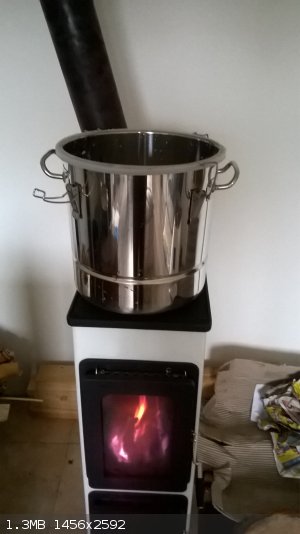
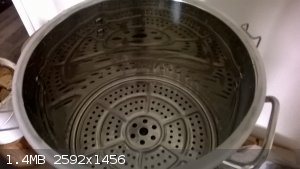
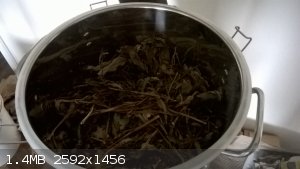
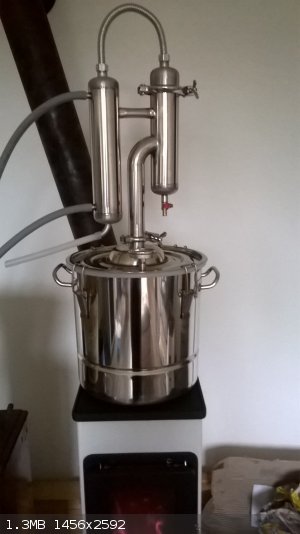
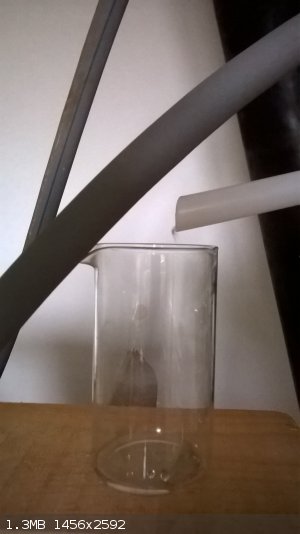
[Edited on 8-10-2019 by Fery]
|
|
|
FluoroPunch
Harmless

Posts: 33
Registered: 13-4-2019
Location: Canada
Member Is Offline
|
|
Quote: Originally posted by Fery  | This is my new steam distillation apparatus. I loaded it with 165 grams of dried herb of Mentha piperita. The yield of oil was 1 ml. This was just
some testing batch. More than 1 kg of dry Mentha from this year harvest from my garden is waiting for processing. The boiler volume is 20 liters from
which 5 liters at bottom is for water and 15 liters space for the herb. Because of economy I use my wood burning stove as I have all wood for free
from my forest. Well not really free, it does require some work and care of trees.
Thanks for sharing. Your setup looks very good, I'm jealous haha. I guess mint just has crappy yield so that explains why I got next to nothing.
[Edited on 8-10-2019 by Fery] |
|
|
|
Sedit
International Hazard
    
Posts: 1939
Registered: 23-11-2008
Member Is Offline
Mood: Manic Expressive
|
|
I have extensive experience with Steam distilling and yet Mint rarely produced anything significant. I have been able to get noticeable amounts using
DCM to extract the Hydrosol and evaportating the DCM off later but mostly Mint is just one of those pain in the ass things and to make it worse I
always hated the smell of greenery after steam distilling it. Just has a rotten smell to it.
Knowledge is useless to useless people...
"I see a lot of patterns in our behavior as a nation that parallel a lot of other historical processes. The fall of Rome, the fall of Germany — the
fall of the ruling country, the people who think they can do whatever they want without anybody else's consent. I've seen this story
before."~Maynard James Keenan
|
|
|
Fery
International Hazard
    
Posts: 1015
Registered: 27-8-2019
Location: Czechoslovakia
Member Is Offline
|
|
From the 165 g of dry mint I distilled about 500 ml of distillate (most of water and some drops of oil inside). Then I transferred the distillate into
1 l distillation flask and did second distillation (to reduce the volume of water). I distilled 25 ml into very small beaker and collected the oil
using pipette. The mint was 10 years old or maybe more. This year mint is waiting for processing (good task for winter, when burning wood in my
stove).
I've bought the distillation apparatus recently (5000 CZK = 200 EUR) so the first batch was only testing.
I have also a lot of Melissa officinalis which harvesting is still pending (when rains stop). This year mint is already under roof and drying for more
than 2 weeks. The next year I'll probably try to grow dill for obtaining the dill essence. About 30 plants of Juniperus communis are growing in my
forest at its south border (border with an agricultural field, so sunny side), I bought them more than 5 years ago in a forest nursery and put them
into my forest, they were so small that time... about 20 cm high (high is not the right word). Juniperus communis fruits will be also something
interesting for distilling. Some people fermentate them first and then distill (gin, in CZ such alcoholic distillate is borovicka), the amount of oil
is so high that only a part dissolves in alcoholic beverage and a lot of it could be collected from the top of distillate.
Here the mint oil in 10 ml flask. I will post results from this year fresh harvest later as this 1 ml is from 165 grams of really ooooold mint (more
than 10 years old, the herb was stored in an open plastic bag). But good to know that after so many years there is still some oil inside...
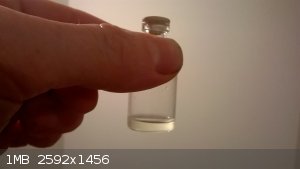
|
|
|
Fery
International Hazard
    
Posts: 1015
Registered: 27-8-2019
Location: Czechoslovakia
Member Is Offline
|
|
After processing 960 g of dry herb of Mentha piperita the yield of oil was 8 ml so the flask at the picture from the previous post is almost full. I
can't explain why the yield was so high, references say the oil content is 0,3-0,4% in dry herb. I got the plant 30 years ago from an elderly woman,
it is nothing special unlike today when there are plenty of special cultivars... In my garden it is growing in an ideal place which is moist and
sunny, this year corn plants were slightly shading it.
Here my processing method which I repeated twice to process the whole herb:
4 l of water was put into the 20 l still, then plate, then half a kilo of dry herb.
Half a liter of water with oil was distilled into a half liter flask so the oil was floating in the neck of the flask from which it was collected
using a pipette.
The minty water with some oily spots at the surface was distilled again and 50 ml of distillate was collected into small narrow beaker from which the
floating oil was collected using a pipette (this added extra about 1 ml of oil).
This method completely avoids using organic solvents (when you redistill minty water from previous step you have smaller volume of distillate so in
narrower beaker it is easier to pipette the floating oil).
|
|
|
Magpie
lab constructor
    
Posts: 5939
Registered: 1-11-2003
Location: USA
Member Is Offline
Mood: Chemistry: the subtle science.
|
|
FYI here's the results of my steam distillation of various natural products done several years ago:
1. Cloves. Direct steam distilled cloves to obtain clove oil - principally eugenol and 2-methyl-4-propylphenol. 6.0125g cloves gave
0.3875 g oil (6.4%). Steam distillate extracted with CH2Cl2.
2. Sage. (Artemsia tridentata) 20.1g of ground sage leaves yielded 3mL of a golden oil (after distillate extracted w/CH2Cl2).
Direct steam method used. GC-MS determined major components: camphor, eucalyptol, & methyl salicylate.
3. Arborvitae. Live steam distilled 20.138g of pulverized leaves from my backyard. extracted distillate w/CH2Cl2. Yield about 3mL
of a golden oil. GC-MS major components: thujone, camphor, methyl salicylate, bornyl acetate, 3-carvene, bicyclic hydroxy derivative, phenanthrene
derivative, norkeurene derivative.
4. Caraway seeds. Direct steam distilled 26.435g of seeds giving ~1ml of oil after distillate extracted with CH2Cl2. Principal
components: (+)-carvone and limonene. Yield: 0.4822g.
The single most important condition for a successful synthesis is good mixing - Nicodem
|
|
|
| Pages:
1
2 |